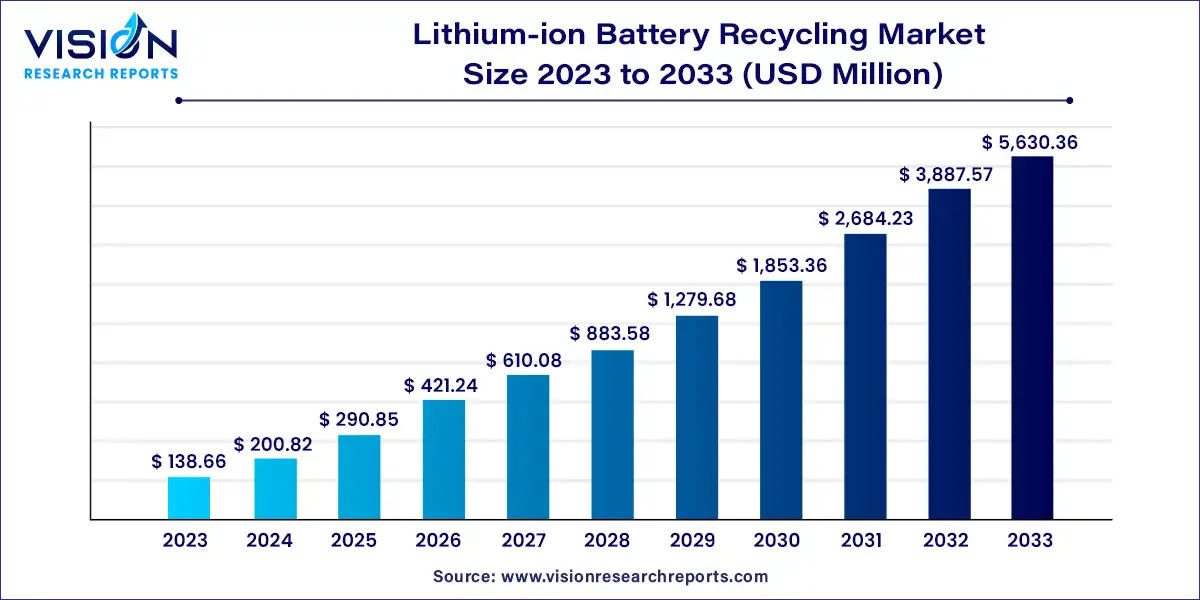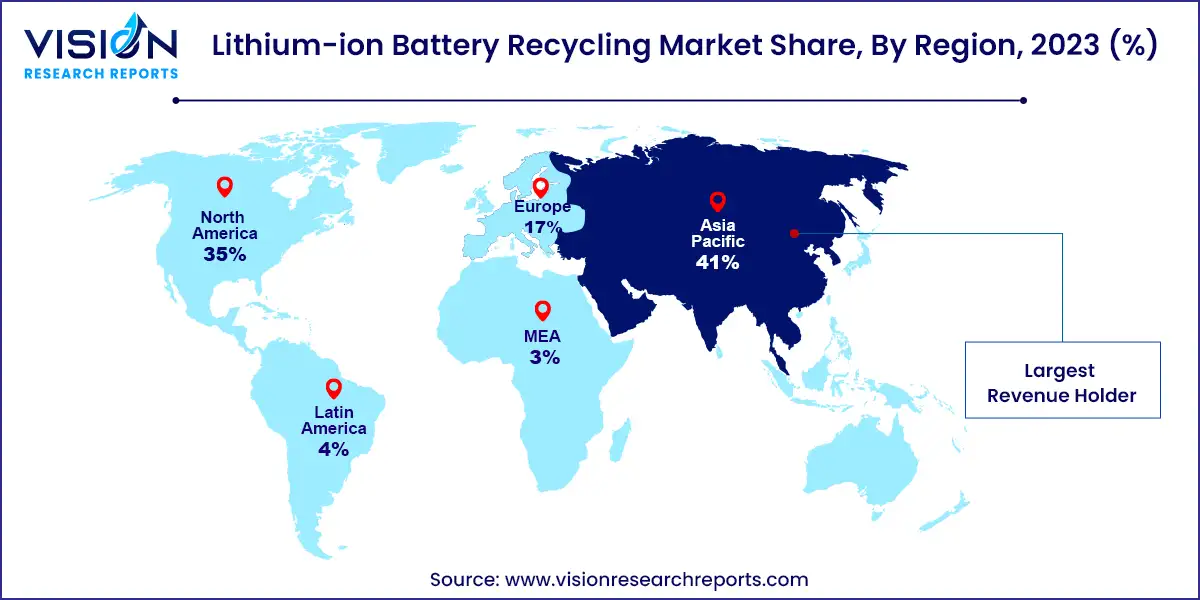The global lithium-ion battery recycling market size was valued at USD 138.66 million in 2023 and it is predicted to surpass around USD 5,630.36 million by 2033 with a CAGR of 44.83% from 2024 to 2033.

The lithium-ion battery recycling market has gained significant traction in recent years due to the growing demand for electric vehicles (EVs), portable electronics, and renewable energy storage systems. Lithium-ion batteries are integral to these technologies, offering high energy density and long lifespan. However, their disposal at end-of-life poses environmental challenges and the loss of valuable resources.
The growth of the lithium-ion battery recycling market is driven by an increasing adoption of electric vehicles (EVs) and the proliferation of portable electronics have heightened the demand for lithium-ion batteries, necessitating efficient recycling solutions to manage end-of-life batteries responsibly. Secondly, stringent environmental regulations and government policies promoting sustainable practices have spurred investments in recycling infrastructure. Thirdly, the recycling of lithium-ion batteries enables the recovery of valuable metals such as lithium, cobalt, nickel, and manganese, reducing reliance on primary sources and ensuring a stable supply chain for these critical materials.
The transportation sector led the market, capturing a substantial revenue share of 69 in 2023. Lithium-ion batteries are favored in transportation due to their advantages such as high discharge tolerance, improved energy density, long cycle life, rapid recharge capability, and minimal memory effect. Recycled batteries find application in stationary energy storage systems within the automotive industry, offering a sustainable solution for grid stabilization and integration of renewable energy sources. Similarly, the electronics sector reuses these batteries to manufacture new products like wearables, computers, and smartphones, reducing dependence on virgin resources.
The transportation segment is projected to exhibit the highest compound annual growth rate (CAGR) during the forecast period. Factors driving this growth include increasing awareness of environmental sustainability, rising demand for electric vehicles, and other related factors. Additionally, the industrial segment is expected to experience significant growth in battery manufacturing and recycling, driven by demand from sectors such as consumer electronics, renewable energy storage, aerospace, and medical devices. Industries value lithium-ion batteries for their high energy density, longevity, and rechargeable properties.
North America is poised to grow at a substantial CAGR throughout the forecast period, fueled by increasing demand for cleaner energy sources.
The United States leads the market with significant investments in recycling facilities and the development of new infrastructure. For instance, in July 2023, Stellantis and Samsung SDI announced plans to establish a second Star Plus Energy Gigafactory in the U.S., slated to begin production in early 2027.

In 2023, the Asia Pacific region dominated the global market. Growth drivers include cost-effective battery solutions, rapid adoption of electric vehicles due to heightened awareness of sustainable mobility, and robust sales of consumer electronics. Population growth in countries like China and India further bolsters market expansion.
The lithium-ion battery recycling market in China is experiencing robust demand growth, driven by environmental concerns, technological advancements, and government support. Efforts focus on developing innovative processes to recover valuable materials from spent batteries and enhance recycling efficiency.
By Application
By Region
Chapter 1. Introduction
1.1. Research Objective
1.2. Scope of the Study
1.3. Definition
Chapter 2. Research Methodology
2.1. Research Approach
2.2. Data Sources
2.3. Assumptions & Limitations
Chapter 3. Executive Summary
3.1. Market Snapshot
Chapter 4. Market Variables and Scope
4.1. Introduction
4.2. Market Classification and Scope
4.3. Industry Value Chain Analysis
4.3.1. Raw Material Procurement Analysis
4.3.2. Sales and Distribution Channel Analysis
4.3.3. Downstream Buyer Analysis
Chapter 5. COVID 19 Impact on Lithium-ion Battery Recycling Market
5.1. COVID-19 Landscape: Lithium-ion Battery Recycling Industry Impact
5.2. COVID 19 - Impact Assessment for the Industry
5.3. COVID 19 Impact: Global Major Government Policy
5.4. Market Trends and Opportunities in the COVID-19 Landscape
Chapter 6. Market Dynamics Analysis and Trends
6.1. Market Dynamics
6.1.1. Market Drivers
6.1.2. Market Restraints
6.1.3. Market Opportunities
6.2. Porter’s Five Forces Analysis
6.2.1. Bargaining power of suppliers
6.2.2. Bargaining power of buyers
6.2.3. Threat of substitute
6.2.4. Threat of new entrants
6.2.5. Degree of competition
Chapter 7. Competitive Landscape
7.1.1. Company Market Share/Positioning Analysis
7.1.2. Key Strategies Adopted by Players
7.1.3. Vendor Landscape
7.1.3.1. List of Suppliers
7.1.3.2. List of Buyers
Chapter 8. Global Lithium-ion Battery Recycling Market, By Application
8.1. Lithium-ion Battery Recycling Market, by Application Type, 2024-2033
8.1.1. Transportation
8.1.1.1. Market Revenue and Forecast (2021-2033)
8.1.2. Electronics
8.1.2.1. Market Revenue and Forecast (2021-2033)
8.1.3. Industrial
8.1.3.1. Market Revenue and Forecast (2021-2033)
Chapter 9. Global Lithium-ion Battery Recycling Market, Regional Estimates and Trend Forecast
9.1. North America
9.1.1. Market Revenue and Forecast, by Application (2021-2033)
9.1.2. U.S.
9.1.2.1. Market Revenue and Forecast, by Application (2021-2033)
9.1.3. Rest of North America
9.1.3.1. Market Revenue and Forecast, by Application (2021-2033)
9.2. Europe
9.2.1. Market Revenue and Forecast, by Application (2021-2033)
9.2.2. UK
9.2.2.1. Market Revenue and Forecast, by Application (2021-2033)
9.2.3. Germany
9.2.3.1. Market Revenue and Forecast, by Application (2021-2033)
9.2.4. France
9.2.4.1. Market Revenue and Forecast, by Application (2021-2033)
9.2.5. Rest of Europe
9.2.5.1. Market Revenue and Forecast, by Application (2021-2033)
9.3. APAC
9.3.1. Market Revenue and Forecast, by Application (2021-2033)
9.3.2. India
9.3.2.1. Market Revenue and Forecast, by Application (2021-2033)
9.3.3. China
9.3.3.1. Market Revenue and Forecast, by Application (2021-2033)
9.3.4. Japan
9.3.4.1. Market Revenue and Forecast, by Application (2021-2033)
9.3.5. Rest of APAC
9.3.5.1. Market Revenue and Forecast, by Application (2021-2033)
9.4. MEA
9.4.1. Market Revenue and Forecast, by Application (2021-2033)
9.4.2. GCC
9.4.2.1. Market Revenue and Forecast, by Application (2021-2033)
9.4.3. North Africa
9.4.3.1. Market Revenue and Forecast, by Application (2021-2033)
9.4.4. South Africa
9.4.4.1. Market Revenue and Forecast, by Application (2021-2033)
9.4.5. Rest of MEA
9.4.5.1. Market Revenue and Forecast, by Application (2021-2033)
9.5. Latin America
9.5.1. Market Revenue and Forecast, by Application (2021-2033)
9.5.2. Brazil
9.5.2.1. Market Revenue and Forecast, by Application (2021-2033)
9.5.3. Rest of LATAM
9.5.3.1. Market Revenue and Forecast, by Application (2021-2033)
Chapter 10. Company Profiles
10.1. Contemporary Amperex Technology Co., Limited
10.1.1. Company Overview
10.1.2. Product Offerings
10.1.3. Financial Performance
10.1.4. Recent Initiatives
10.2. LG Energy Solution
10.2.1. Company Overview
10.2.2. Product Offerings
10.2.3. Financial Performance
10.2.4. Recent Initiatives
10.3. Panasonic Corporation
10.3.1. Company Overview
10.3.2. Product Offerings
10.3.3. Financial Performance
10.3.4. Recent Initiatives
10.4. SAMSUNG SDI CO., LTD.
10.4.1. Company Overview
10.4.2. Product Offerings
10.4.3. Financial Performance
10.4.4. Recent Initiatives
10.5. BYD
10.5.1. Company Overview
10.5.2. Product Offerings
10.5.3. Financial Performance
10.5.4. Recent Initiatives
10.6. SVOLT Energy
10.6.1. Company Overview
10.6.2. Product Offerings
10.6.3. Financial Performance
10.6.4. Recent Initiatives
10.7. Tesla
10.7.1. Company Overview
10.7.2. Product Offerings
10.7.3. Financial Performance
10.7.4. Recent Initiatives
10.8. Shenzhen Manly Battery Co.
10.8.1. Company Overview
10.8.2. Product Offerings
10.8.3. Financial Performance
10.8.4. Recent Initiatives
10.9. TOSHIBA CORPORATION
10.9.1. Company Overview
10.9.2. Product Offerings
10.9.3. Financial Performance
10.9.4. Recent Initiatives
10.10. SK on Co., Ltd
10.10.1. Company Overview
10.10.2. Product Offerings
10.10.3. Financial Performance
10.10.4. Recent Initiatives
Chapter 11. Research Methodology
11.1. Primary Research
11.2. Secondary Research
11.3. Assumptions
Chapter 12. Appendix
12.1. About Us
12.2. Glossary of Terms
 Cross-segment Market Size and Analysis for
Mentioned Segments
Cross-segment Market Size and Analysis for
Mentioned Segments
 Additional Company Profiles (Upto 5 With No Cost)
Additional Company Profiles (Upto 5 With No Cost)
 Additional Countries (Apart From Mentioned Countries)
Additional Countries (Apart From Mentioned Countries)
 Country/Region-specific Report
Country/Region-specific Report
 Go To Market Strategy
Go To Market Strategy
 Region Specific Market Dynamics
Region Specific Market Dynamics Region Level Market Share
Region Level Market Share Import Export Analysis
Import Export Analysis Production Analysis
Production Analysis Others
Others